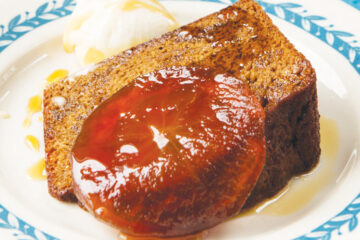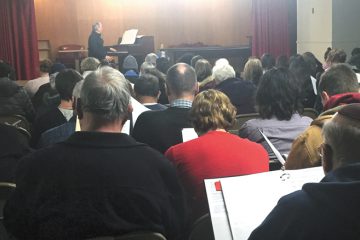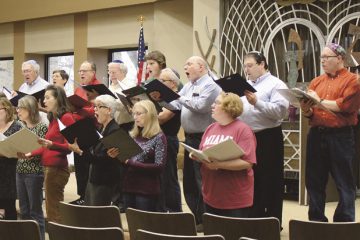The shofar: the birthing of the world

By Cantor Jenna Greenberg
As we approach the High Holy Days season, many symbols come to mind: apples and honey, round challot, the white Torah covers and kittels (prayer robes).
Among the many symbols that represent the Yamim Noraim, these Days of Awe, one of the most powerful and evocative is none other than the shofar itself, the ram’s horn blown from the beginning of the Hebrew month of Elul through the end of the High Holy Days season.
The Hebrew root of the word shofar, the letters shin-feh-resh, means to be good, tov. We say shanah tovah, and we mean that not only should you have a good year, so too, you should be good. You should act positively in the world, improving not only upon yourself but upon the world around you as well. All this will help us to beautify ourselves and the world around us.
Not only does the root of shofar mean a moral good, but it has a physical goodness implied as well, suggesting beauty.

To be kosher, a shofar should be physically beautiful. If it has cracks or holes, these will affect its sound, rendering it unfit for ceremonial use.
Regardless of size, shape, color or texture, it is clear that not only does the shofar need to sound good, but it should look good as well.
If we change the vowels from shofar, we get a very interesting word, also derived from the same Hebrew root: shafir.
It happens to be a common Hebrew name for boys in Israel, as well as a last name, all with the same meaning for shofar, being handsome or beautiful.
In Yiddish, shafir means sapphire, one of the most beautiful and valuable gemstones.
Sapphire was used as one of the 12 precious stones set in the Israelite high priest’s breastplate during his service in the Holy Temple, the Beit HaMikdash.
Just as the shofar’s physical and musical beauty call attention to these holy days and their rituals, so too, the sapphire’s beauty was used for ritual purposes during biblical times.
In Hebrew, shafir has a very different and surprising meaning, amniotic sac, the fluid-filled sac that contains, nourishes, and protects a fetus in the womb. The sac is the fetus’ home during gestation. The amniotic sac grows with the fetus over its incubation period, feeding and protecting the fetus that will celebrate its birthday upon emerging from its mother’s womb, upon its entry into the world.
So what does this biological meaning of shafir have to do with the ritual of blowing the shofar? How can two such extremely different meanings from the same Hebrew root possibly be connected?
One connection between shafir and shofar is the fact that Rosh Hashanah is not only the Jewish New Year, but it also celebrates the birthday of the world, announced by the primal sounds of the shofar itself.
For as we can see in the liturgy, following the three sets of shofar calls during the Musaf Amidah, the final section of the morning prayers, we chant the words Hayom Harat Olam, today is the birthday of the world.
But this birth, the birthing of the world, happens through the sound that the shofar makes.
Throughout the entire year, we say in our morning prayers, “Baruch she’amar v’haya ha’olam, Blessed is the One who spoke and the world was created!” Perhaps God’s voice at that moment sounded like the shofar; Divine speech is a holy sound after all.
Shortly after creating the world, God breathed life into the first human being, Adam, for God is the Giver of life. As it says in Gen. 2:7, “God blew into his nostrils nishmat chayim, the breath of life, and man became a living being.”
The ba’al tekiah, shofar blower, breathes into the shofar the many blasts, sounding tekiah, shevarim, truah, and of course all of these build up to tekiah gedola, that great final breath that pushes the air out, that brings new life into the world.
Without air, the shofar would not sound. Without air, life would not be given.
The imagery of the shofar as a ritual musical instrument paired with an understanding of shafir as the amniotic sac is a fascinating parallel. We all are ultimately hoping for a rebirth of ourselves in the New Year.
It is a reflective time to think about how we can live up to what the shofar calls, and its Hebrew root suggest to each of us: be good, beautiful people as we look ahead to the year to come.
Lastly, we have gematria, mystical numerology, where every Hebrew letter has a numerical equivalent. This Kabalistic (mystical) code has the ability to leave us with both a mathematical and spiritual interpretation.
The gematria, or numeric value, of the word shofar, equals 586. When you add up each of these three numbers (5 + 8 + 6 = 19), and then add up those two numbers (1 + 9), our sum is 10: a significant number in Judaism (10 commandments, 10 for minyan, a prayer quorum).
Unique to this holy season, 10 is the number of days we have to be improved, shupar, also from the original root for shofar. We refer to this period as Aseret Y’mei Teshuvah, the Ten days of Repentance.
While we may not be able to “improve” ourselves by the end of this holy 10-day period, we can all make an effort to strategize achievable goals for the new year 5778.
May the shofar within each of us sound out, helping to direct us toward rebirth and self-improvement for the year to come. L’ Shanah Tovah.
Cantor Jenna Greenberg is director of The Dayton Jewish Chorale.
To read the complete September 2017 Dayton Jewish Observer, click here.





